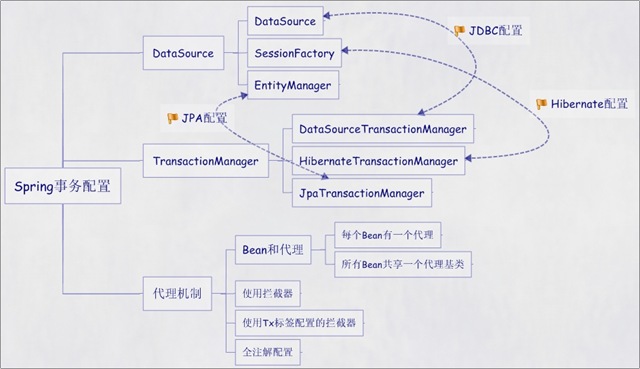Spring配置文件中关于事务配置总是由三个组成部分,分别是DataSource、TransactionManager和代理机制这三部分,无论哪种配置方式,一般变化的只是代理机制这部分。
DataSource、TransactionManager这两部分只是会根据数据访问方式有所变化,比如使用hibernate进行数据访问时,DataSource实际为SessionFactory,TransactionManager的实现为HibernateTransactionManager。
具体如下图:
根据代理机制的不同,总结了五种Spring事务的配置方式,配置文件如下:
第一种方式:每个Bean都有一个代理
< beans xmlns ="http://www.springframework.org/schema/beans"
xmlns:xsi ="http://www.w3.org/2001/XMLSchema-instance"
xmlns:context ="http://www.springframework.org/schema/context"
xmlns:aop ="http://www.springframework.org/schema/aop"
xsi:schemaLocation ="http://www.springframework.org/schema/beans
http://www.springframework.org/schema/beans/spring-beans-2.5.xsd
http://www.springframework.org/schema/context
http://www.springframework.org/schema/context/spring-context-2.5.xsd
http://www.springframework.org/schema/aop http://www.springframework.org/schema/aop/spring-aop-2.5.xsd" >
< bean id ="sessionFactory"
class ="org.springframework.orm.hibernate3.LocalSessionFactoryBean" >
< property name ="configLocation" value ="classpath:hibernate.cfg.xml" />
< property name ="configurationClass" value ="org.hibernate.cfg.AnnotationConfiguration" />
</ bean >
<!-- 定义事务管理器(声明式的事务) -->
< bean id ="transactionManager"
class ="org.springframework.orm.hibernate3.HibernateTransactionManager" >
< property name ="sessionFactory" ref ="sessionFactory" />
</ bean >
<!-- 配置DAO -->
< bean id ="userDaoTarget" class ="com.bluesky.spring.dao.UserDaoImpl" >
< property name ="sessionFactory" ref ="sessionFactory" />
</ bean >
< bean id ="userDao"
class ="org.springframework.transaction.interceptor.TransactionProxyFactoryBean" >
<!-- 配置事务管理器 -->
< property name ="transactionManager" ref ="transactionManager" />
< property name ="target" ref ="userDaoTarget" />
< property name ="proxyInterfaces" value ="com.bluesky.spring.dao.GeneratorDao" />
<!-- 配置事务属性 -->
< property name ="transactionAttributes" >
< props >
< prop key ="*" > PROPAGATION_REQUIRED </ prop >
</ props >
</ property >
</ bean >
</ beans >
第二种方式:所有Bean共享一个代理基类
< beans xmlns ="http://www.springframework.org/schema/beans"
xmlns:xsi ="http://www.w3.org/2001/XMLSchema-instance"
xmlns:context ="http://www.springframework.org/schema/context"
xmlns:aop ="http://www.springframework.org/schema/aop"
xsi:schemaLocation ="http://www.springframework.org/schema/beans
http://www.springframework.org/schema/beans/spring-beans-2.5.xsd
http://www.springframework.org/schema/context
http://www.springframework.org/schema/context/spring-context-2.5.xsd
http://www.springframework.org/schema/aop http://www.springframework.org/schema/aop/spring-aop-2.5.xsd" >
< bean id ="sessionFactory"
class ="org.springframework.orm.hibernate3.LocalSessionFactoryBean" >
< property name ="configLocation" value ="classpath:hibernate.cfg.xml" />
< property name ="configurationClass" value ="org.hibernate.cfg.AnnotationConfiguration" />
</ bean >
<!-- 定义事务管理器(声明式的事务) -->
< bean id ="transactionManager"
class ="org.springframework.orm.hibernate3.HibernateTransactionManager" >
< property name ="sessionFactory" ref ="sessionFactory" />
</ bean >
< bean id ="transactionBase"
class ="org.springframework.transaction.interceptor.TransactionProxyFactoryBean"
lazy-init ="true" abstract ="true" >
<!-- 配置事务管理器 -->
< property name ="transactionManager" ref ="transactionManager" />
<!-- 配置事务属性 -->
< property name ="transactionAttributes" >
< props >
< prop key ="*" > PROPAGATION_REQUIRED </ prop >
</ props >
</ property >
</ bean >
<!-- 配置DAO -->
< bean id ="userDaoTarget" class ="com.bluesky.spring.dao.UserDaoImpl" >
< property name ="sessionFactory" ref ="sessionFactory" />
</ bean >
< bean id ="userDao" parent ="transactionBase" >
< property name ="target" ref ="userDaoTarget" />
</ bean >
</ beans >
第三种方式:使用拦截器
< beans xmlns ="http://www.springframework.org/schema/beans"
xmlns:xsi ="http://www.w3.org/2001/XMLSchema-instance"
xmlns:context ="http://www.springframework.org/schema/context"
xmlns:aop ="http://www.springframework.org/schema/aop"
xsi:schemaLocation ="http://www.springframework.org/schema/beans
http://www.springframework.org/schema/beans/spring-beans-2.5.xsd
http://www.springframework.org/schema/context
http://www.springframework.org/schema/context/spring-context-2.5.xsd
http://www.springframework.org/schema/aop http://www.springframework.org/schema/aop/spring-aop-2.5.xsd" >
< bean id ="sessionFactory"
class ="org.springframework.orm.hibernate3.LocalSessionFactoryBean" >
< property name ="configLocation" value ="classpath:hibernate.cfg.xml" />
< property name ="configurationClass" value ="org.hibernate.cfg.AnnotationConfiguration" />
</ bean >
<!-- 定义事务管理器(声明式的事务) -->
< bean id ="transactionManager"
class ="org.springframework.orm.hibernate3.HibernateTransactionManager" >
< property name ="sessionFactory" ref ="sessionFactory" />
</ bean >
< bean id ="transactionInterceptor"
class ="org.springframework.transaction.interceptor.TransactionInterceptor" >
< property name ="transactionManager" ref ="transactionManager" />
<!-- 配置事务属性 -->
< property name ="transactionAttributes" >
< props >
< prop key ="*" > PROPAGATION_REQUIRED </ prop >
</ props >
</ property >
</ bean >
< bean class ="org.springframework.aop.framework.autoproxy.BeanNameAutoProxyCreator" >
< property name ="beanNames" >
< list >
< value > *Dao </ value >
</ list >
</ property >
< property name ="interceptorNames" >
< list >
< value > transactionInterceptor </ value >
</ list >
</ property >
</ bean >
<!-- 配置DAO -->
< bean id ="userDao" class ="com.bluesky.spring.dao.UserDaoImpl" >
< property name ="sessionFactory" ref ="sessionFactory" />
</ bean >
</ beans >
第四种方式:使用tx标签配置的拦截器
< beans xmlns ="http://www.springframework.org/schema/beans"
xmlns:xsi ="http://www.w3.org/2001/XMLSchema-instance"
xmlns:context ="http://www.springframework.org/schema/context"
xmlns:aop ="http://www.springframework.org/schema/aop"
xmlns:tx ="http://www.springframework.org/schema/tx"
xsi:schemaLocation ="http://www.springframework.org/schema/beans
http://www.springframework.org/schema/beans/spring-beans-2.5.xsd
http://www.springframework.org/schema/context
http://www.springframework.org/schema/context/spring-context-2.5.xsd
http://www.springframework.org/schema/aop http://www.springframework.org/schema/aop/spring-aop-2.5.xsd
http://www.springframework.org/schema/tx http://www.springframework.org/schema/tx/spring-tx-2.5.xsd" >
< context:annotation-config />
< context:component-scan base-package ="com.bluesky" />
< bean id ="sessionFactory"
class ="org.springframework.orm.hibernate3.LocalSessionFactoryBean" >
< property name ="configLocation" value ="classpath:hibernate.cfg.xml" />
< property name ="configurationClass" value ="org.hibernate.cfg.AnnotationConfiguration" />
</ bean >
<!-- 定义事务管理器(声明式的事务) -->
< bean id ="transactionManager"
class ="org.springframework.orm.hibernate3.HibernateTransactionManager" >
< property name ="sessionFactory" ref ="sessionFactory" />
</ bean >
< tx:advice id ="txAdvice" transaction-manager ="transactionManager" >
< tx:attributes >
< tx:method name ="*" propagation ="REQUIRED" />
</ tx:attributes >
</ tx:advice >
< aop:config >
< aop:pointcut id ="interceptorPointCuts"
expression ="execution(* com.bluesky.spring.dao.*.*(..))" />
< aop:advisor advice-ref ="txAdvice"
pointcut-ref ="interceptorPointCuts" />
</ aop:config >
</ beans >
第五种方式:全注解
< beans xmlns ="http://www.springframework.org/schema/beans"
xmlns:xsi ="http://www.w3.org/2001/XMLSchema-instance"
xmlns:context ="http://www.springframework.org/schema/context"
xmlns:aop ="http://www.springframework.org/schema/aop"
xmlns:tx ="http://www.springframework.org/schema/tx"
xsi:schemaLocation ="http://www.springframework.org/schema/beans
http://www.springframework.org/schema/beans/spring-beans-2.5.xsd
http://www.springframework.org/schema/context
http://www.springframework.org/schema/context/spring-context-2.5.xsd
http://www.springframework.org/schema/aop http://www.springframework.org/schema/aop/spring-aop-2.5.xsd
http://www.springframework.org/schema/tx http://www.springframework.org/schema/tx/spring-tx-2.5.xsd" >
< context:annotation-config />
< context:component-scan base-package ="com.bluesky" />
< tx:annotation-driven transaction-manager ="transactionManager" />
< bean id ="sessionFactory"
class ="org.springframework.orm.hibernate3.LocalSessionFactoryBean" >
< property name ="configLocation" value ="classpath:hibernate.cfg.xml" />
< property name ="configurationClass" value ="org.hibernate.cfg.AnnotationConfiguration" />
</ bean >
<!-- 定义事务管理器(声明式的事务) -->
< bean id ="transactionManager"
class ="org.springframework.orm.hibernate3.HibernateTransactionManager" >
< property name ="sessionFactory" ref ="sessionFactory" />
</ bean >
</ beans >
此时在DAO上需加上@Transactional注解,如下:
import java.util.List;
import org.hibernate.SessionFactory;
import org.springframework.beans.factory.annotation.Autowired;
import org.springframework.orm.hibernate3.support.HibernateDaoSupport;
import org.springframework.stereotype.Component;
import com.bluesky.spring.domain.User;
@Transactional
@Component( " userDao " )
public class UserDaoImpl extends HibernateDaoSupport implements UserDao {
public List < User > listUsers() {
return this .getSession().createQuery( " from User " ).list();
}

}
| 一、Propagation (事务的传播属性) Propagation : key属性确定代理应该给哪个方法增加事务行为。这样的属性最重要的部份是传播行为。有以下选项可供使用: PROPAGATION_REQUIRED--支持当前事务,如果当前没有事务,就新建一个事务。这是最常见的选择。 PROPAGATION_SUPPORTS--支持当前事务,如果当前没有事务,就以非事务方式执行。 PROPAGATION_MANDATORY--支持当前事务,如果当前没有事务,就抛出异常。 PROPAGATION_REQUIRES_NEW--新建事务,如果当前存在事务,把当前事务挂起。 PROPAGATION_NOT_SUPPORTED--以非事务方式执行操作,如果当前存在事务,就把当前事务挂起。 PROPAGATION_NEVER--以非事务方式执行,如果当前存在事务,则抛出异常。 1: PROPAGATION_REQUIRED 加入当前正要执行的事务不在另外一个事务里,那么就起一个新的事务 比如说,ServiceB.methodB的事务级别定义为PROPAGATION_REQUIRED, 那么由于执行ServiceA.methodA的时候, ServiceA.methodA已经起了事务,这时调用ServiceB.methodB,ServiceB.methodB看到自己已经运行在ServiceA.methodA 的事务内部,就不再起新的事务。而假如ServiceA.methodA运行的时候发现自己没有在事务中,他就会为自己分配一个事务。 这样,在ServiceA.methodA或者在ServiceB.methodB内的任何地方出现异常,事务都会被回滚。即使ServiceB.methodB的事务已经被 提交,但是ServiceA.methodA在接下来fail要回滚,ServiceB.methodB也要回滚 2: PROPAGATION_SUPPORTS 如果当前在事务中,即以事务的形式运行,如果当前不再一个事务中,那么就以非事务的形式运行 3: PROPAGATION_MANDATORY 必须在一个事务中运行。也就是说,他只能被一个父事务调用。否则,他就要抛出异常 4: PROPAGATION_REQUIRES_NEW 这个就比较绕口了。 比如我们设计ServiceA.methodA的事务级别为PROPAGATION_REQUIRED,ServiceB.methodB的事务级别为PROPAGATION_REQUIRES_NEW, 那么当执行到ServiceB.methodB的时候,ServiceA.methodA所在的事务就会挂起,ServiceB.methodB会起一个新的事务,等待ServiceB.methodB的事务完成以后, 他才继续执行。他与PROPAGATION_REQUIRED 的事务区别在于事务的回滚程度了。因为ServiceB.methodB是新起一个事务,那么就是存在 两个不同的事务。如果ServiceB.methodB已经提交,那么ServiceA.methodA失败回滚,ServiceB.methodB是不会回滚的。如果ServiceB.methodB失败回滚, 如果他抛出的异常被ServiceA.methodA捕获,ServiceA.methodA事务仍然可能提交。 5: PROPAGATION_NOT_SUPPORTED 当前不支持事务。比如ServiceA.methodA的事务级别是PROPAGATION_REQUIRED ,而ServiceB.methodB的事务级别是PROPAGATION_NOT_SUPPORTED , 那么当执行到ServiceB.methodB时,ServiceA.methodA的事务挂起,而他以非事务的状态运行完,再继续ServiceA.methodA的事务。 6: PROPAGATION_NEVER 不能在事务中运行。假设ServiceA.methodA的事务级别是PROPAGATION_REQUIRED, 而ServiceB.methodB的事务级别是PROPAGATION_NEVER , 那么ServiceB.methodB就要抛出异常了。 7: PROPAGATION_NESTED 理解Nested的关键是savepoint。他与PROPAGATION_REQUIRES_NEW的区别是,PROPAGATION_REQUIRES_NEW另起一个事务,将会与他的父事务相互独立, 而Nested的事务和他的父事务是相依的,他的提交是要等和他的父事务一块提交的。也就是说,如果父事务最后回滚,他也要回滚的。 而Nested事务的好处是他有一个savepoint。 ***************************************** ServiceA { /** * 事务属性配置为 PROPAGATION_REQUIRED */ void methodA() { try { //savepoint ServiceB.methodB(); //PROPAGATION_NESTED 级别 } catch (SomeException) { // 执行其他业务, 如 ServiceC.methodC(); } } } ******************************************** 也就是说ServiceB.methodB失败回滚,那么ServiceA.methodA也会回滚到savepoint点上,ServiceA.methodA可以选择另外一个分支,比如 ServiceC.methodC,继续执行,来尝试完成自己的事务。 但是这个事务并没有在EJB标准中定义。 二、Isolation Level(事务隔离等级): 1、Serializable:最严格的级别,事务串行执行,资源消耗最大; 2、REPEATABLE READ:保证了一个事务不会修改已经由另一个事务读取但未提交(回滚)的数据。避免了“脏读取”和“不可重复读取”的情况,但是带来了更多的性能损失。 3、READ COMMITTED:大多数主流数据库的默认事务等级,保证了一个事务不会读到另一个并行事务已修改但未提交的数据,避免了“脏读取”。该级别适用于大多数系统。 4、Read Uncommitted:保证了读取过程中不会读取到非法数据。隔离级别在于处理多事务的并发问题。 我们知道并行可以提高数据库的吞吐量和效率,但是并不是所有的并发事务都可以并发运行,这需要查看数据库教材的可串行化条件判断了。 这里就不阐述。 我们首先说并发中可能发生的3中不讨人喜欢的事情 1: Dirty reads--读脏数据。也就是说,比如事务A的未提交(还依然缓存)的数据被事务B读走,如果事务A失败回滚,会导致事务B所读取的的数据是错误的。 2: non-repeatable reads--数据不可重复读。比如事务A中两处读取数据-total-的值。在第一读的时候,total是100,然后事务B就把total的数据改成 200,事务A再读一次,结果就发现,total竟然就变成200了,造成事务A数据混乱。 3: phantom reads--幻象读数据,这个和non-repeatable reads相似,也是同一个事务中多次读不一致的问题。但是non-repeatable reads的不一致是因为他所要取的数据集被改变了(比如total的数据),但是phantom reads所要读的数据的不一致却不是他所要读的数据集改变,而是他的条件数据集改变。比如Select account.id where account.name="ppgogo*",第一次读去了6个符合条件的id,第二次读取的时候,由于事务b把一个帐号的名字由"dd"改成"ppgogo1",结果取出来了7个数据。
三、readOnly 事务属性中的readOnly标志表示对应的事务应该被最优化为只读事务。 这是一个最优化提示。在一些情况下,一些事务策略能够起到显著的最优化效果,例如在使用Object/Relational映射工具(如:Hibernate或TopLink)时避免dirty checking(试图“刷新”)。 四、Timeout 在事务属性中还有定义“timeout”值的选项,指定事务超时为几秒。在JTA中,这将被简单地传递到J2EE服务器的事务协调程序,并据此得到相应的解释 |
